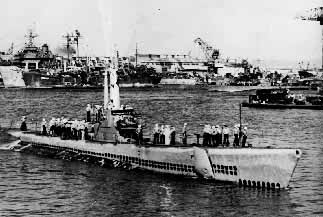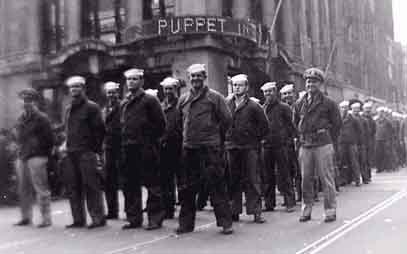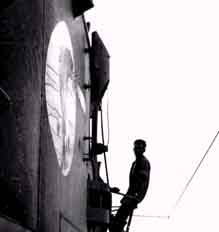|
 USS
REQUIN was commissioned on April 28, 1945 at the Portsmouth Naval Shipyard
in New Hampshire. One of the 80 Tench-class hulls planned, REQUIN was
one of 25 actually built and one of only two surviving examples. Externally,
REQUIN was similar to her sister submarines of the Gato and Balao classes,
except for the squared-off forefoot. Internally, however, was where many
of the changes from the earlier two classes of fleet submarines were incorporated.
In the beginning, REQUIN carried the normal armament for a fleet sub.
Equipped with six torpedo tubes forward and four aft, REQUIN could initially
carry a total of 24 torpedoes (ten torpedoes in the tubes, 6 forward and
4 aft, plus 14 reloads). On deck, perhaps because her first skipper was
one of the most decorated submarine commanders, Commander Slade D. Cutter,
REQUIN carried heavier armament than usual. In addition to the two 5 inch/25
caliber deck guns (one forward and one aft of the conning tower), REQUIN
also carried two 40 mm rapid fire cannons, which were mounted on the forward
and aft cigarette decks on the conning tower. As an experiment, REQUIN
also carried two 24-tube 5-inch rocket launchers, which were to have been
used in an offshore bombardment capacity for the supposed invasion of
the Japanese home islands. USS
REQUIN was commissioned on April 28, 1945 at the Portsmouth Naval Shipyard
in New Hampshire. One of the 80 Tench-class hulls planned, REQUIN was
one of 25 actually built and one of only two surviving examples. Externally,
REQUIN was similar to her sister submarines of the Gato and Balao classes,
except for the squared-off forefoot. Internally, however, was where many
of the changes from the earlier two classes of fleet submarines were incorporated.
In the beginning, REQUIN carried the normal armament for a fleet sub.
Equipped with six torpedo tubes forward and four aft, REQUIN could initially
carry a total of 24 torpedoes (ten torpedoes in the tubes, 6 forward and
4 aft, plus 14 reloads). On deck, perhaps because her first skipper was
one of the most decorated submarine commanders, Commander Slade D. Cutter,
REQUIN carried heavier armament than usual. In addition to the two 5 inch/25
caliber deck guns (one forward and one aft of the conning tower), REQUIN
also carried two 40 mm rapid fire cannons, which were mounted on the forward
and aft cigarette decks on the conning tower. As an experiment, REQUIN
also carried two 24-tube 5-inch rocket launchers, which were to have been
used in an offshore bombardment capacity for the supposed invasion of
the Japanese home islands.
 REQUIN,
though, would not get to use her weapons in anger. After completing a
period of training off Panama in June of 1945, REQUIN made her way from
the Canal Zone to Pearl Harbor, where she began preparations for her first
war patrol. In port on August 15, 1945, the crew of REQUIN received word
that World War II was over, just three days before she was to leave on
her first war patrol. After taking part in ceremonies marking the end
of the war, REQUIN received orders to return to the United States and
become part of the Atlantic Fleet. Arriving in Staten Island in late September
1945, REQUIN began what would be "a dull and boring assignment", in the
words of Slade Cutter, which lasted almost one year, essentially becoming
a target for sonar school ships. REQUIN,
though, would not get to use her weapons in anger. After completing a
period of training off Panama in June of 1945, REQUIN made her way from
the Canal Zone to Pearl Harbor, where she began preparations for her first
war patrol. In port on August 15, 1945, the crew of REQUIN received word
that World War II was over, just three days before she was to leave on
her first war patrol. After taking part in ceremonies marking the end
of the war, REQUIN received orders to return to the United States and
become part of the Atlantic Fleet. Arriving in Staten Island in late September
1945, REQUIN began what would be "a dull and boring assignment", in the
words of Slade Cutter, which lasted almost one year, essentially becoming
a target for sonar school ships.
 |
 |
 |
Three photos
from early in REQUIN's career:
The photo at
top left shows REQUIN's crew getting ready to march down Pratt Street
(I think) in Baltimore, during the Navy Day Parade in October, 1945.
The top right
photo shows a view of REQUIN's conning tower, with the crew insignia
on the side.
The photo at
left shows REQUIN pulling into Guantanomo Bay, Cuba...sometime in
1946. (Courtesy of Don Belden)
|
In October 1946, Commander
George Street, a Medal of Honor winner during the war, took over as REQUIN's
commanding officer. With this change in command, REQUIN would also receive
a new assignment, one in which she would operate for the next 12 to 13
years.
|





